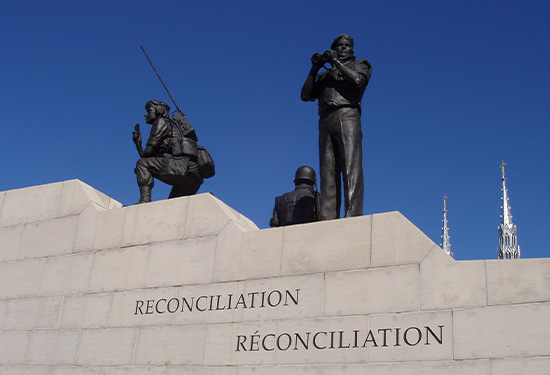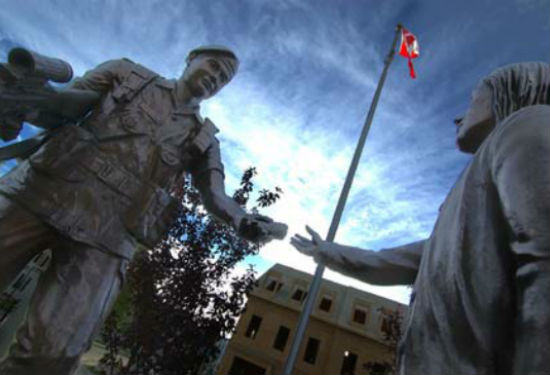Lieutenant (N) Gerry White
Retired Naval Officer and Former RCMP member Gerry White served with the UN in Cambodia after the Khmer Rouge killed 1.5 million citizens. What he witnessed still haunts him but he takes solace in the fact he was able to bring some comfort and joy to children left destitute by years of war.
Cambodia

Joined
On his 19th birthday May 29, 1974 in Corner Brook, Newfoundland
Postings
- Regina, Saskatchewan
- Holyrood, Nfld
- Glovertown, Nfld
- Placentia, Nfld
- Victoria, B.C.
- Quebec City, Quebec
- Canadian Forces Station Shelburne, N.S.
Deployments
- HMCS Saskatchewan
- HMCS Kootenay
- Cornwallis CF Company Commander
- HMCS Ottawa
- CF Halifax combat training
- HMCS Protecteur Combat Officer
- HMCS Margaree Combat Officer
- Royal 22 Regiment Combat School Quebec City
- Naval Reserve HQ
- UN special element
- Operations Officer CFS Shelburne
- Naval Operations School Halifax
- HMCS Halifax
- Defence Research and Development Atlantic
- The Baltic
- Cold War deployment as part of NATO’s Standing Naval Force Atlantic
- Mediterranean
- South America
- Samploy 78
- Galapagos Islands
- Machu Picchu
Lieutenant (N) Gerry White
Warning: this content involves graphic subject matter that some may find disturbing. Reader discretion is advised.
If you are a Veteran, family member or caregiver in need of mental health support, the VAC Assistance Service is available to you 24/7, 365 days a year at no cost. Call 1-800-268-7708 to speak to a mental health professional right now.
Losing his Dad in a tragic mill accident on Fathers’ Day at age eight, Gerry White’s life was marked by adversity.
Three decades later, White, a former RCMP member, now a Naval Operations Officer, found himself deployed to help restore order in Cambodia. The southeast Asian country was in chaos after 1.5 million citizens were killed by the Khmer Rouge regime.
Most of the children in the country were left orphaned after years of civil war and foreign intervention.
Despite his difficult and dangerous mission to help restore peace and order, White found some solace in easing the children’s suffering.
In 1992, White, then 37, was deployed as an element commander at Ream Naval Base in Kampong-Som in southern Cambodia as part of the largest UN deployment since the Korean War. More than 20,000 military and police personnel from over 40 countries joined this mission. White was among thirty Canadian sailors serving UN naval detachments sent to patrol the Mekong and Tonlé Sap Rivers and The Gulf of Thailand. They were there to seize weapons and ammunition, as well as monitor refugee movements, cease-fire violations and smugglers.
That was their official mission.
But White and his team had a personal mission to bring some comfort and joy to the children growing up in the aftermath of “The Killing Fields,” and set out to do so.
“There were thirty Canadians over there with big hearts – all handpicked – and we all had kids of our own and there is absolutely no difference between my eight-year-old and their eight-year-old—they’re beautiful children, except my kids have everything and they need everything.”
“So you find whatever you can scrounge, you’d give away your own ration pack at the end of the day.”
The children living in villages along the riverbanks with few adults were initially cautious of “the UNTACs” (United Nations Transitional Authority in Cambodia) in their Russian river patrol boat “Peace in Cambodia” written on its bow. White’s bilingualism helped him communicate with many Cambodians who spoke French after decades of colonial rule.
Not wearing combat fatigues “combats scare kids; we didn’t wear them” and not carrying guns “that’s probably what kept us alive,” White and his team of peacekeepers nosed their boat into riverbanks at the edge of well-worn villagers’ foot paths.
The 200 boxes of toys shipped from Canada helped coax the fearful children out.
And when White played “You are my Sunshine” on his harmonica they slowly came out of the woods around the villages.

Gerry White plays his “Big Bertha” harmonica, the same one he played for Cambodian children when he served with the UNTAC in 1992.
Then the peacekeepers “set up shop” – handing out toys (Etch-a-Sketch and Mr. Potato Head were favourites), shampooing little heads with lice shampoo, passing out whatever medicines they could get their hands on, and twisting open cans of corned beef hash “they would add some lemongrass and make a meal of it.”
Weeks later when they sailed past the same villages, the banks were lined with children waving the empty corned beef hash cans shouting “Canada, Canada.”
Being able to help the children who had suffered great loss and sadness like he had as a boy helped White deal with the horrors of war.
“We were deployed to a place called The Killing Fields. Fill in the blanks.”
Many of the mines laid during the Vietnam war were dislodged in the rainy seasons and floated into low laying rice paddies where young children worked picking rice for their families.
The little plastic waterproof landmines settled in the sediment for years. Children working to feed their families lost legs and hands when they dislodged them.
“We dealt with the results of children who had stepped on or picked up mines,” White said, remembering one little girl smiling for pictures with her amputated hand held behind her back.
He says those children still visit him in the night.
“Those things carve themselves into your brain – it goes in and won’t go away.”
The contrast to North American wealth and the poverty Cambodian children faced was stark.
“Our kids are worried about having the latest iPhone or the newest version of sneakers – they just want to be alive at the end of the day when the sun goes down,” he said.
“So you go and you give them a hand.”
For his military career and many volunteer efforts since his retirement, White was inducted into the Order of St. George, a Chivalric Order whose Mission is “to better the health and well-being of members of the Canadian Armed Forces, Veterans and their families.” It is given to those who have done important things for the Commonwealth or foreign nations. He was also commended for his bravery by the Deputy Chief of Defence Vice-Admiral Greg Maddison.
He credits the success of the UNTAC mission on “the finest group of peacekeepers ever assembled.”
White is humble about his military awards and recognitions. He’d rather talk about his family, his love for his wife, singing tenor in Nova Scotia’s Mass Choir, the weekly Veterans’ coffee klatsch he enjoys so much – or the Cambodian children.
“Children restore your faith for the future. They’re the promise of the future.”
With courage, integrity and loyalty, Gerry White is leaving his mark. He is one of our Canadian Armed Forces members. Discover more stories.
Back to poster


















































